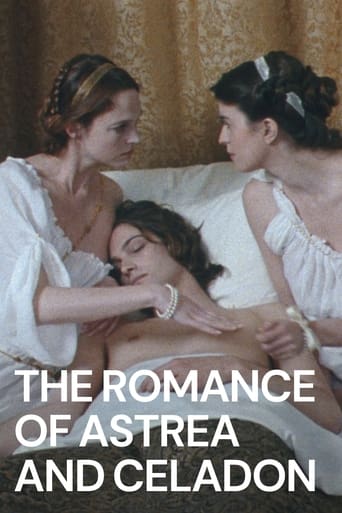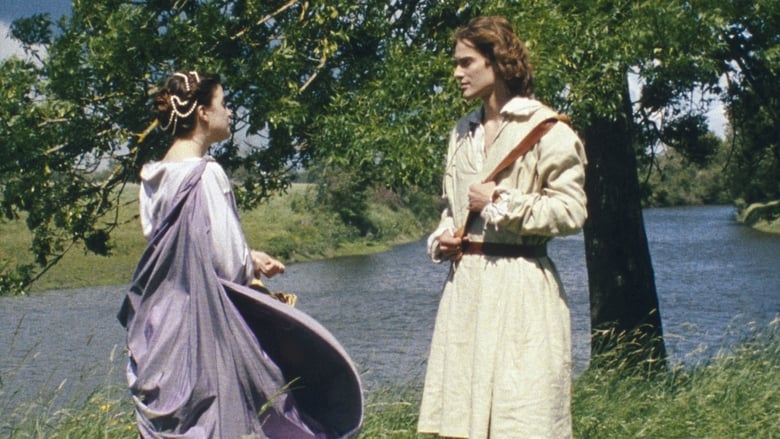

The Romance of Astrea and Celadon (2007)
In an enchanted forest, back in the time of the Druids, the shepherd Céladon and the shepherdess Astrée share a pure and chaste love. Fooled by a suitor, Astrée dismisses Céladon, who throws himself into a river out of despair. She thinks he's dead, but he's been secretly rescued by some nymphs. Faithful to the promise he made to Astrée to never appear before her again, Céladon must overcome many obstacles to break the curse. Mad with love and despair, coveted by the nymphs, surrounded by rivals, and obliged to disguise himself as a woman to be near the one he loves, will he manage to make himself known without breaking his oath? A romance filled with doubt, hazards, and delicious temptations.
Watch Trailer
Cast


Reviews
This was Eric Rohmer's last movie, which he made in 2007 at 87 (he would die three years later). He decided to close his distinguished career by filming a famous French pastoral novel of the 1600s, considered unfilmable by those who have read it. Rohmer, who before becoming a director was a professor of French Literature, has always been one of the most literary of all directors. The action takes place in an anachronistic, fantastic Gaul among a rural community of shepherds. The silly, absurd plot (which is never played for laughs) has the shepherd Celadon fled the village after his love Astrea suspects him of "making merry" with another shepherdess during a party there. Astrea is led to believe that he drowned in the river while fleeing, and she mourns him madly, but he has actually been rescued by a community of nymphs, who live in a renaissance-style castle and whose leader is mad with Celadon and doesn't let him leave the place (in the film, every woman is madly in love with Celadon). One of the nymphs eventually gets the head druid involved (who sputters platitudes and new age like nonsense and is played by Serge Renko, who was the Soviet spy in Triple Agent - Rohmer's previous, great film, sadly little known). Not very profound, and a bit of a gimmick, this bucolic, languid film is pleasant to watch. The young, little known beautiful actors, who always say their lines in perfectly enunciated French, help.
I had a bad time with the last medieval-set film from Eric Rohmer, Perceval le Gallois, generally because it was shot on sets and I found Fabrice Luchini as Perceval incredibly annoying. Having an interest in the literature of the time I was uncomfortable with the portrayal.So I came to this one with misgivings, but fortunately it allowed some of the source material to breathe. The film is based on a 17th century novel called L'Astrée by Honoré d'Urfé. It is set in 5th Century France and is a romantic fantasy of the times. It seems that all characters are either shepherds, shepherdesses, nymphs or druids. I feel that Rohmer's style is quite inflexible, he shot this movie in squarish 4:3, as usual, whereas I felt the languor of the material, the playful Arcadian tone, the respect for the landscape (that Rohmer professes at the start of the film) required a more horizontal treatment of 2.35:1. Full-screen is what Rohmer typically uses and is good for his conversational films, or portraiture if you will. Here the material begs for something different, think for example of the British romantic painters William Etty and Lord Leighton, of Leighton's The Daphnephoria, Etty's The World Before The Flood, long sensual paintings. Rohmer does however try his best to find scenes that look best under 4:3, for example when Astrea takes her flock to high pasture up a steep meadow, there's no other way the scene should be filmed, it's more a case of Rohmer fitting the world to his aspect ratio though. I think that what works best for Rohmer in nearly all of his other films was a weakness here, the spartan conversational style.Celadon is a prince who has decided to live as a shepherd, having presciently followed Voltaire's advice that working the land is the key to happiness. He is loved by Astrea, a shepherdess. A tragic miscommunication between the two leads to their separation and peregrinations. Along the way we are treated to the usual Rohmerian banter about how love can't be forced, elective affinities, and the rationalisations and sophistries of love that each of the characters own. The main chat is between Hylas and Lycidas. Hylas is the equivalent of the bumble bee, he believes that men are meant to flit like bees from flower to flower, he is a joyful larger-than-life character. Lycidas on the other hand believes in monogamous love (with his beloved Phillis), a fusion of souls and both openly scorn the other, though Lycidas comes off as dour. I'm not convinced the philosophical material is a move forward from his earlier movies such as Pauline a la Plage, but it certainly is presented here with enough charm.The source material is well over 5000 pages long and obviously here we have a massive condensation. You can sense this quite often, for example when Celadon contemplates a painting of Psyche dripping hot wax on the sleeping Cupid. The painting is loaded with context, it's describing a scene from Apuleius' The Golden Ass, the only fully-surviving Latin novel, the whole episode is a rich and dense allegory regarding Platonism and different types of love, it's just skipped over here.The movie definitely is a pleasure to watch for me, despite the extravagance that the tale yearns to be told with, and which is barely present here. I don't think there is any director alive, or any budget that would see full justice done to the story, I think Rohmer succeeded as much as can be expected.
French film "Les Amours D'Astrée Et De Céladon" is absolutely Rohmerian in essence but still relatively easy to follow.It is probably one of the simplest films made by French new wave master Eric Rohmer.Apart from entertaining die hard art cinema admirers,this is a film which would be of great use to students of French language and literature as it makes effective use of simple French language for its lively dialogs full of charm and wit.Eric Rohmer has also created a marvelous feast for eyes as the portrayal of ancient times is artistic,innovative and remarkably honest.One has to appreciate that Rohmer's choice of young actors is brilliant especially Andy Gillet and Stéphanie Crayencour who add an endearing touch to their magnanimous depiction of truthful lovers Céladon and Astrée.Although there is no hint of any kind of inherent eroticism,those who can read between the lines can decipher that this ancient love story is erotic purely out of its own accord. Les amours d'Astrée et de Céladon/The loves of Astrée and of Celadon is a true love story which must be seen by anyone who has ever fallen in love.
Rohmer has made great films so if he makes a strange or apparently bad film it's wiser to check if it's our expectations that are at fault, not the film. Celadon & Astrae is an odd film and I don't think it's a great film, but I don't think it's a bad one. It has conventions- as all films do- but they aren't conventional conventions so it takes time to adjust to them but it is worth adjusting and accepting the preposterous plot, the formal archaic language and the absurd psychology. There's actually a very Rohmeric film here with beautiful fluid filming and a Rohmeric concern with morality and the actors aren't trapped by the conventions they must act in: Astrea and Celadon's sorrows and joys may be conventional and absurd objectively but they are still moving and the debates are absurd in form but relevant in subject.




